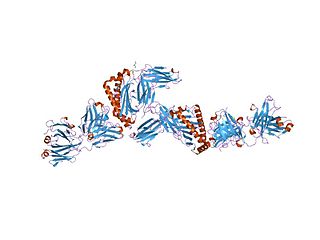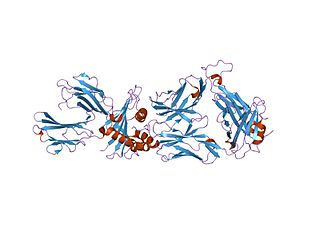
Melanotransferrin is a protein that in humans is encoded by the MFI2 gene. MFI2 has also recently been designated CD228.

Melanoma-associated antigen 1 is a protein that in humans is encoded by the MAGEA1 gene.

Cancer/testis antigen 1 also known as LAGE2 or LAGE2B is a protein that in humans is encoded by the CTAG1B gene. It is most often referenced by its alias NY-ESO-1.

Melanoma-associated antigen 3 (MAGE-A3) is a protein that in humans is encoded by the MAGEA3 gene.

Melanoma-associated antigen D1 is a protein that in humans is encoded by the MAGED1 gene.

Melanoma-associated antigen 4 is a protein that in humans is encoded by the MAGEA4 gene.

Melanoma-associated antigen 2 is a protein that in humans is encoded by the MAGEA2 gene.

Melanoma-associated antigen C2 is a protein that in humans is encoded by the MAGEC2 gene.

Melanoma-associated antigen D2 is a protein that in humans is encoded by the MAGED2 gene.

Melanoma-associated antigen B2 is a protein that in humans is encoded by the MAGEB2 gene.

Melanoma-associated antigen H1 is a protein that in humans is encoded by the MAGEH1 gene.

Melanoma-associated antigen 11 is a protein that in humans is encoded by the MAGEA11 gene. It is also involved in the androgen and progesterone receptor signaling pathways.

Probable ATP-dependent RNA helicase DDX43 is an enzyme that in humans is encoded by the DDX43 gene.

Melanoma-associated antigen 12 is a protein that in humans is encoded by the MAGEA12 gene.

Melanoma-associated antigen D4 is a protein that in humans is encoded by the MAGED4B gene.

Melanoma-associated antigen 9 is a protein that in humans is encoded by the MAGEA9 gene.
Cancer/testis (CT) antigens are a group of proteins united by their importance in development and in cancer immunotherapy. In general, expression of these proteins is restricted to male germ cells in the adult animal. However, in cancer these developmental antigens are often re-expressed and can serve as a locus of immune activation. Thus, they are often classified as tumor antigens. The expression of CT antigens in various malignancies is heterogeneous and often correlates with tumor progression. CT antigens have been described in melanoma, liver cancer, lung cancer, bladder cancer, and pediatric tumors such as neuroblastoma. Gametogenesis offers an important role for many of these antigens in the differentiation, migration, and cell division of primordial germ cells, spermatogonia spermatocytes and spermatids. Because of their tumor-restricted expression and strong in vivo immunogenicity, CT antigens are identified as ideal targets for tumor specific immunotherapeutic approaches and prompted the development of several clinical trials of CT antigens-based vaccine therapy. CT antigens have been found to have at least 70 families so far, including about 140 members, most of which are expressed during spermatogenesis. Their expression are mainly regulated by epigenetic events, specifically, DNA methylation.

T lymphocytes are cells of the immune system that attack and destroy virus-infected cells, tumor cells and cells from transplanted organs. This occurs because each T cell is endowed with a highly specific receptor that can bind to an antigen present at the surface of another cell. The T cell receptor binds to a complex formed by a surface protein named "MHC" and a small peptide of about 9 amino-acids, which is located in a groove of the MHC molecule. This peptide can originate from a protein that remains within the cell. Whereas each T cell recognizes a single antigen, collectively the T cells are endowed with a large diversity of receptors targeted at a wide variety of antigens. T cells originate in the thymus. There a process named central tolerance eliminates the T cells that have a receptor recognizing an antigen present on normal cells of the organism. This enables the T cells to eliminate cells with "foreign" or "abnormal" antigens without harming the normal cells.

MAGEA10 is a protein-coding gene in humans clustered at chromosomal location Xq28.

SPANX family member B1 is a protein that in humans is encoded by the SPANXB1 gene.








